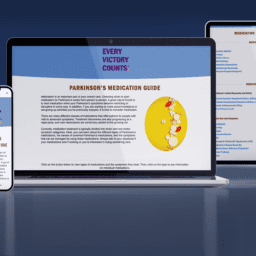Have you noticed yourself or your person with Parkinson’s repetitively counting coins, sorting buttons, disassembling a flashlight, or polishing their nails? It might not be disruptive or dangerous, but it’s hard for them to stop. They might get irritable when you distract them from it or not seem fully aware of what they’re doing. If you recognize any of these traits, you or your person with Parkinson’s might be experiencing punding.
What is punding?
Punding is defined as an intense fascination with complex, repetitive activities that are not goal-oriented and don’t offer any real gratification. For example, people with Parkinson’s who experience punding often report that their punding helps them soothe a feeling of intense curiosity or tension.
Some common examples of punding include examining collections of objects repeatedly, taking objects apart, counting small items, sorting things, or grooming oneself. Studies suggest that women tend to impulsively tidy things, brush their hair, or sort through their handbags. Men more commonly fixate on technology by taking apart, arranging, and sorting the pieces of engines, clocks, or radios. Punding behaviors are also often linked to the person’s own life: an avid gardener might be unable to stop pulling weeds, whereas someone who enjoys sewing could repetitively but purposelessly sort buttons.

The behaviors that characterize punding are usually not harmful, but they can be embarrassing and isolating for the punder or their care partner. Punding can also be awkward or disruptive in relationships with partners, family members, colleagues, and friends, so learning more about what causes punding and how to address it is essential.
Impulse control disorders and dopamine agonists
One of the most common side effects for people with Parkinson’s who take dopamine agonists is Impulse Control Disorders (ICDs). ICDs may result in excessive and compulsive gambling, hypersexuality, shopping, and eating. A lesser-known example is punding.
If you’ve noticed impulsive and repetitive behaviors, you may have wondered whether you or your person with Parkinson’s has obsessive-compulsive disorder (OCD). However, ICDs (including punding) are not the same as OCD. They are both repetitive, potentially isolating, and difficult to control for the person experiencing them. But while punders can be distracted from their tasks, people with OCD cannot. Additionally, punding is usually not driven by the same sorts of uncontrollable anxieties, obsessions, or pleasures as OCD; instead, it is often linked to someone’s personal history.
But what causes punding? Research suggests that punding, like other ICDs, is linked to dopaminergic replacement therapy (DRT). One type of DRT is dopamine agonists (DAs), one of the most commonly prescribed Parkinson’s medications. DAs mimic the effects of dopamine in the brain, making them very effective for treating Parkinson’s. However, taking DRT over a long period can cause you to develop a tolerance, so your doctor may need to increase your dosage to ensure you keep getting the same benefits. Also, long-term high doses can overstimulate specific dopamine receptors, which researchers believe causes punding. Finally, there is some evidence that long-term levodopa use, another form of DRT, may also be implicated.

When to talk to your doctor
Because punding can be frustrating or embarrassing, you might not feel like mentioning it to your doctor. However, early intervention can stop punding before it worsens and talking to a doctor is key. Punding is relatively rare: it’s estimated that between 0.34 and 4.2 percent of all people with Parkinson’s and up to 14% of people with Parkinson’s who take more than 800 mg of levodopa per day experience punding. Because of those low rates, your primary care physician or family doctor might not be as aware of how to treat punding. However, talking to a movement disorder specialist (MDS) can be very helpful, as they can adjust your medications appropriately. Occupational therapists – especially those who specialize in movement disorders or psychiatric disorders such as OCD – can also be a great resource. They can help you combat unproductive behaviors in tandem with the sorts of medication adjustments that an MDS can provide.
If you notice any symptoms of punding, even if they seem unobtrusive, it’s worth mentioning it to your doctor. Because early intervention is the best way to stop punding, bringing your concerns to a doctor can jumpstart treatment to improve your quality of life. Consider keeping a list of any behaviors reminiscent of punding, how often they occur, and how long they last. You can also note how your person with Parkinson’s reacts to being distracted from their punding activity and any other changes in their behavior.

Punding treatments
Your doctor may recommend many possible therapies to help reduce punding or stop it altogether. Because punding is believed to be related to high-dose, long-term DRT use, one of the first steps your doctor might take is to reduce your DA and/or levodopa dosage. They may also recommend that you avoid taking “rescue doses” of DRT, especially at night.
Some medications may be helpful in addition to or instead of changing your DRT dosage. For example, if you experience worsening motor symptoms with a decreased dose, your doctor might suggest switching to entacapone because it has been shown not to cause punding. They may also suggest taking quetiapine or amantadine, avoiding classic neuroleptics, or considering deep brain stimulation (DBS). However, it’s important to remember that Parkinson’s treatment is highly individualized, and what works for one person might not work for others. Be sure to check in with your doctor before making any changes to your medications.
Learn more
Want to learn more about ICDs, medications, and talking to your doctor? Explore general information on ICDs and Parkinson’s or read our primer on Parkinson’s medications. You can also learn more about building your care team and get advice from people with Parkinson’s about maximizing your time with your doctor.












